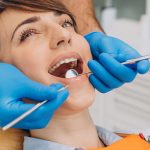
Teeth may change color due to genetic factors, medications used, tartar accumulation, external factors (tea, coffee, cigarettes, etc.) and aging.
In teeth that have changed color, superficial external discolorations can be removed by brushing and tartar cleaning, while deeper stains require a whitening process.
Whitening procedures are of two types: home-type whitening and office-type whitening.
WHAT IS OFFICE TYPE WHITENING?
It is the fastest and most effective whitening method. It is applied by the dentist in the clinic by applying a whitening agent to the patient’s teeth. The dentist begins the whitening process by applying a protective gel to the patient’s gums and soft tissues. The whitening agent applied to the teeth is activated by light application (blue light) or chemically. Depending on the preference of the patient and the physician, the whitening process can be repeated in one or two sessions. Each session consists of 3 15-minute sections. The biggest advantage of this system is that the result can be seen within 30-45 minutes.
WHAT IS HOME WHITENING?
Transparent mouth plates are prepared by taking measurements of the patient. The whitening gels prescribed by the doctor are squeezed into the prepared trays and the patient is asked to keep them in their mouth for 3-4 hours a day. The duration of the application varies depending on the intensity and color of the person’s teeth discoloration, the shade of the tooth discoloration, and the sensitivity that may occur in the teeth.
Are your teeth sensitive?
With Bio Whitening Technology, specially developed for sensitive teeth, you can have a comfortable smile without experiencing sensitivity.
WHICH TEETH CAN BE APPLIED?
- In yellow or brown colored teeth,
- In teeth that have turned yellow due to external factors (cigarettes, tea, coffee, etc.),
- Slightly yellow and gray teeth due to antibiotic (tetracycline) use,
- In dark colored (devital) teeth that have lost their vitality,
- In teeth with fluorosis without enamel loss,
IN WHICH CASES SHOULD IT NOT BE APPLIED?
- In pregnant or breastfeeding women,
- In people with tooth sensitivity,
- In worn and ruined teeth (teeth with excessive enamel loss),
- For people with peroxide and latex allergies,
- Teeth whitening should not be performed on people receiving chemotherapy and radiotherapy.










